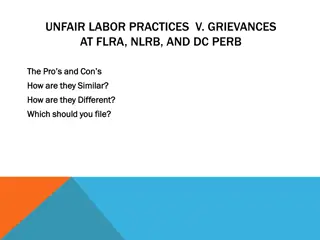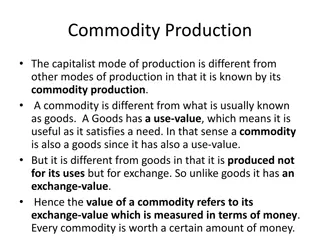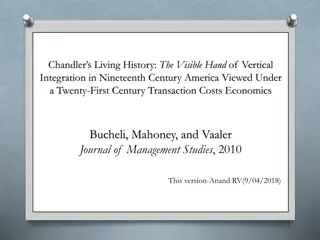Effective Labor Cost Control Procedures for Organizational Success
Significance of labor cost control in production, methods to control labor costs, organizational procedures, labor turnover calculation, and methods of recording attendance time to ensure productivity and efficiency in the workplace.
Download Presentation

Please find below an Image/Link to download the presentation.
The content on the website is provided AS IS for your information and personal use only. It may not be sold, licensed, or shared on other websites without obtaining consent from the author. Download presentation by click this link. If you encounter any issues during the download, it is possible that the publisher has removed the file from their server.
E N D
Presentation Transcript
Subscribe my YouTube channel Commerce Yuga & THE FAIR TRUTH https://youtu.be/8bbDzmaAD5 o https://youtu.be/5_SkZovAVK U
Significance of Labor cost control- factor of production that is active and it makes other factors active. No any other factor can replace labor. Labor control techniques creates discipline in the organization. It checks wastages. Components of labor cost.- the cost on labor may be both monetary or non monetary. labor is such a
Labor cost control procedure there may be two method to control labor cost. 1) Managerial procedure- the following steps may be in managerial procedure- a) setting up standards b) Use of labor budget c) study of effectiveness of wages policy d) Production planning e) labor performance report
2) Operational procedure- this includes the following- a) proper determination labor requirment b) scientific selection of labors c) right person at right place d) proper accounting of presence of labor e) proper recording and computation of wages f) determination of wages payment g) control on idle time h) proper training i) control of absentees j) time and motion study
3) Organizational procedure- a) Personnel department b) Engineering and work study department c) Time and accounting department d) Wages table department e) Cost accounting department
Labor turnover- the ratio between employees discharged or resigned at a particular time to the total employees in the organization, is called labor turn over- Formula to calculate labor turnover- a) separation method- No. of separated emp. average emp. b) Replacement method- No. of emp. Replaced average employees Flux method : separated emp. + replaced emp. average employees c)
Methods of recording attendance time- the following are the method for this purpose- 1) Attendance register or muster roll 2) by metal discs or tokens 3) by time recording clock Time utilization record or time booking- it is very important to record working hour of employees this boost the productivity and efficiency and put effective control over the employees. The following objectives may be achieved by this- Calculate idle time Computation of cost of production Computation wages To know efficiency of labor 1) 2) 3) 4)
To record time different organization use different books , however, following books are generally use to record time- Daily time sheet Weekly time sheet Job card 1) 2) 3) Record of casual work : sometime the organization appoints some extra workforce on agreement basis. This may be to fulfill some extra work requirement. Such workers are for temporary basis and after completion of work or time they are discharged.
Idle time- the time at which the worker dont work or stays idle, is called idle time. There may be many reason for idle time- A) inefficient management B) Unscientific planning C) Negligence of officers D) Conflict between employees and employers E) Economic reason F) Special reason there are two types of loss related to idle time- a) Normal loss- 1) time taken in motion from one door to department b) refreshment time c) Time take to move from one job to another on machine to another
2) Abnormal loss- 1) failure of machine 2) conflict 3) negligence of managers Accounting for idle time- it is recorded in two method- 1) in form of inflated salary 2) In form of Overhead Overtime When a worker works more than normal working hour, it is said that he is doing overtime. The following are the reason of overtime- 1) increase in the demand 2) insufficient workers 3) use of perishable raw material 4) prompt completion of order 5) inefficient management 6) lack of place or machine in the factory
Loss of overtime- the followings are the loss of overtime- Low efficiency of workers Increase of cost of production Low quality product Failure of health of employees 1) 2) 3) 4)
Method of wages payment: payment of wages is very important matter. There are various principle of wages payment. An idle system of wages payment should be as follow- Acceptance of both parties Easy to calculate Minimum wages gurantee Efficiency oriented Incentive oriented Economy Definite wages base Efficiency oriented Prompt payment facility 10) Flexibility 11) Ability to pay 1) 2) 3) 4) 5) 6) 7) 8) 9)
Method of wages payment : the following are the method of wages payment- A) on the basis of time B) Piece rate system C) Incentives plan i) Premium bonus method a) Halsey premium method b) Rowan premium method ii) combination of time and piece rate system a) Gantt task premium b) Emerson Efficiency premium iii) group system of bonus payment a) priestman s output bonus scheme b) cost bones scheme c) non-monetary incentive scheme
Time rate of wages payment: Time Rate System is otherwise called as Time Work, Day Work, Day Wages and Day Rate. It is the oldest method of remuneration. A worker is paid wages on the basis of number of hours engaged in the production activities. The output of the worker is not considered for payment of wages wages = hours worked * hourly wages rate Merits: 1) old and popular method 2) assurance of wages 3) improvement in production quality 4) good for employees of different category
Limitations : the followings are the demerits- 1) lack of incentive 2) need over supervision 3) no incentive to efficient labor 4) loss due to fall in production 2) Piece rate payment system: Piece rate pay occurs when workers are paid by the unit performed (e.g. the number of tee shirts or bricks produced) instead of being paid on the basis of time spent on the job wages- units produced * rate per units Merits: the following are the merits of this system 1) incentives to workers
2) increase in production 3) fall in production cost 4) Freedom to workers 5) determination of cost price 6) economy in supervision Limitations: the following are the limitations: 1) low quality product 2) fall in health 3) conflict 4) hate feeling for each other 5) misuse of material and machine 6) difficulty in determination of wages 7) not fit for work that is related to art .
Classification of piece rate system: 1) straight piece rate- wages = manufactured units* per units cost 2) Piece rate with graduated time rate: this give guarantee of payment of minimum wages. Daily wages or piece rate wages whichever is more is paid 3) Differentiated piece rate: under this, taylor s differentiated piece rate system is very famous. In this method wages at higher rate is paid to those who achieve standard production and those who fails to achieve the standard are paid wages at low rate.
Halsey premium scheme:- Under Halsey premium plan method, standard time for doing each job or operation is fixed and the worker is given wages for the actual time he takes to complete the job or operation at the agreed rate per hour plus a bonus equal to (usually) one-half of the wages of the time saved Total wages= time taken * hourly rate+ % premium(time saved*hourly rate)
Rowan premium scheme: Rowan premium plan is one of important incentive wage plan which was made by James Rowan of David Rowan and Co. For making this plan, James Rowan had studied the Halsey plan. As per this plan, there is guarantee of minimum wage with time rate. But worker has right to get bonus on the basis of ratio to time saved and standard time. Total wages- times taken*hourly rate+ time saved/standard time*time taken * hourly rate
Combination of time and piece rate scheme- this includes the following method- 1) Gantt task premium scheme- Gant's task and bonus plan is based on careful time and motion study. ... In other words, if a worker's performance is more than 100% he is given piece wages plus bonus at 20% of piece wages. Thus, with every reduction in time, the plan ensures progressive increase in total wages.
B) Emerson Efficiency premium scheme: Emerson Efficiency Plan: This plan was introduced by Mr. Hemington Emerson. Under this plan of incentive wages, the wages are paid at the standard rate and the amount of bonus paid to the workers depends on the individual efficiency of the workers. Calculation of efficiency: actual production/ standard producton or Actual time/ standard time If any worker performs upto 67% or only 2/3rdwork he is paid only normal wages Like wages= actual time* per hour rate More than 67% but less than 100% Wages= (actual time* per hour rate)+(actual time*per hour rate* fluctuated rate of premium ) If more than 100% say 110% Premium= 20%( on 100%) + 10%( on excess) = 30%
2) Bedaux scheme: Definition: The Bedaux Plan is an incentive scheme in which the standard time for the completion of a job is fixed and the rate per hour is defined. Each minute of the standard time is called as point or B, such as in one hour there are 60 Bs and if a worker performs a work for eight hours then he should work for 60*8= 480 Bs. Bonus is paid to those workers who perform task more than standard. Below or equal to standard is not paid.
3) group system of bonus payment: A bonus scheme for a group of workers can be introduced where: 1. It is necessary to have a team work. 2. It is required to reward not only the direct workers but also the indirect workers who assist the direct workers. This develops team spirit among the workers. 3. It is difficult to measure the output of individual workers because the output depends upon the combined efforts of a group of workers. A group bonus is divided among the workers of the group in proportion to the basic wages earned by them.
Advantages: 1. It creates team spirit which in turn leads to high output. 2. It eliminates excessive waste of time because the members of the group divide the work among themselves according to their convenience keeping in view the interest of the group as a whole. 3. It guarantees time wages to the members of a group
4) Workers are likely to maintain flow of production in a group. Hence, a group bonus plan is very useful in activities where a number of processes are involved and the completion of one process depends upon the completion of the previous process. 5. Support workers (i.e., indirect workers) not directly associated with production can easily be included in the group bonus scheme because group bonus can be divided among members of the group in proportion to the basic wages earned by them. 6. It greatly reduces the number of rates to be negotiated. 7. It is easier to manage the scheme because members of the group take care of themselves. It is administratively simpler because less recording of labour times and production rate is required.
Disadvantages: . 1)The share of bonus of efficient workers may be the same as that of inefficient workers because all workers of the group get bonus in proportion to their normal time rate earnings. 2. A group bonus scheme is less direct in approach than individual incentive schemes, so it may not provide the same incentive as individual incentive schemes provide. 3. It may be difficult to obtain agreement on the proportions of the bonus which group members will receive. Hence, there may be a difficulty in the distribution of bonus among members of the group.
Priestmans output bonus scheme: Within this plan the standard output is determined earlier that has to be achieved, say, in a week through the workers as a group in a factory. The standard productivity can be set in terms of units or points. The bonus is paid to them as per to the proportion of increase in output if the workers produce more than the standard output. This is accommodating production bonus plan because all the workers together make efforts to achieve the standards. Bonus percentage= total increased production standard production
2) cost bonus scheme- under this method, at any particular time and in any department if actual cost is less than the standard cost than bonus equivalent to saved cost is distributed among the all worker and staff of that particular department. This method is doubtful because production cost is not fully dependent to efforts of employees other factors also play equal role. Non monetary incentives- this type of incentives are non monetary. Some non monetary benefits are also given to the employees
Thank you Keep learning



























